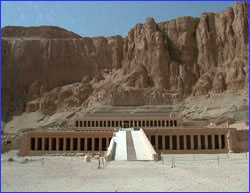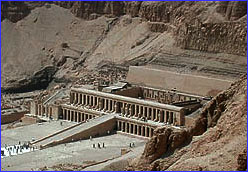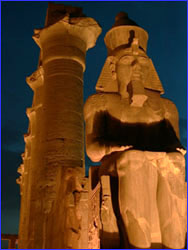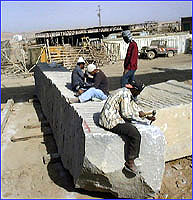
|
 |
 |
by Peter Tyson March 10, 1999 The view from the summit of the mountain known as Meret Seger, or "Lover of Silence," which I climbed yesterday, is magnificent in almost every direction. To the north and west spread the high, desiccated hills of the Valley of the Kings, the tombs of numerous New Kingdom pharaohs punched into them. Far below to the east, a god's lawn of fields stretches to the Nile, a procession of funerary temples marching south along their bursting-green edges. The most intriguing part of the view, however, lies due east. Directly below you—so direct that a misstep could send you hurtling several hundred feet down onto its upper terrace—stands the mortuary temple of the pharaoh Hatshepsut, one of the great obelisk-raisers. From our perch on the barren, flint-strewn summit, the temple's long entrance ramps appear to point toward the rising sun, and if you followed the line they suggested across those green fields and over the Nile, your eye on a clear day would fall on Karnak Temple, the St. Peter's of the New Kingdom. This is exactly what Hatshepsut intended. It was all part of a master plan of monument raising designed in large measure to impress the priests and populace of Thebes.
To placate the powers that be, she went on a building spree, throwing up temples throughout Egypt and Nubia to honor various and sundry local deities. At Thebes, she ordered up the palatial mortuary temple at Deir el-Bahari. Carved into the eroded cliffs below the Lover of Silence, the triple-colonnaded temple is at once one of the masterpieces of ancient Egyptian architecture and utterly unlike any other building in the canon. For our team's purposes, Hatshepsut's most important contributions to Thebes took place at Karnak, where she put up, among many other monuments, no fewer than four obelisks.
To a significant degree, historians owe what little they know of obelisk raising from archaic sources to Hatshepsut. (When I asked how to pronounce her name, our avuncular driver Hagag smiled and said, "Just say 'hot chicken soup.' and you'll be close.") In an inscription at the base of her standing obelisk at Karnak, Hatshepsut describes how long it took to quarry, ship, and uplift the second pair of obelisks she raised there: "My Majesty began work on them in Year 15, second month of Winter, day 1, continuing until Year 16, fourth month of Summer, day 30, making seven months in cutting [them] from the mountain." Scholars don't necessarily believe her claim—seven months seems exaggeratedly brief—but it's the only such reference known. We must thank Hatshepsut, too, for giving us the only insight we have on how the pharaohs transported their obelisks. Our NOVA team specifically went to Hatshepsut's temple yesterday to see the so-called "Obelisk Colonnade." Here, high on a wall of fragmentary plaster that still retains traces of yellow and red paint, I could just make out a relief depicting two obelisks laid end to end on a barge. To the right, an estimated 30 boats, with crews thought to total more than 1,000 men, tow the barge down the Nile. When we get to Aswan, we will try our hand at loading and transporting a two-ton obelisk aboard a similar kind of barge, to get an approximation of the difficulties Hatshepsut's boatbuilders faced.
Next: Tomorrow the team will visit the Great Temple of Amun-Re at Karnak, so large it could hold several football fields. In Aswan, meanwhile, stonemasons are working round-the-clock to fashion a multi-ton granite shaft into an obelisk proper. Peter Tyson is Online Producer of NOVA. Obelisk Raised! (September 12) In the Groove (September 1) The Third Attempt (August 27) Angle of Repose (March 25) A Tale of Two Obelisks (March 24) Rising Toward the Sun (March 23) Into Position (March 22) On an Anthill in Aswan (March 21) Ready to Go (March 20) Gifts of the River (March 19) By Camel to a Lost Obelisk (March 18) The Unfinished Obelisk (March 16) Pulling Together (March 14) Balloon Flight Over Ancient Thebes (March 12) The Queen Who Would Be King (March 10) Rock of Ages (March 8) The Solar Barque (March 6) Coughing Up an Obelisk (March 4) Photos: (1-3) NOVA/WGBH; (4) Courtesy of Roger Hopkins. Explore Ancient Egypt | Raising the Obelisk | Meet the Team Dispatches | Pyramids | E-Mail | Resources Classroom Resources | Site Map | Mysteries of the Nile Home Editor's Picks | Previous Sites | Join Us/E-mail | TV/Web Schedule About NOVA | Teachers | Site Map | Shop | Jobs | Search | To print PBS Online | NOVA Online | WGBH © | Updated November 2000 |
 The upper colonnades of Hatshepsut's mortuary temple
at Deir el-Bahari.
The upper colonnades of Hatshepsut's mortuary temple
at Deir el-Bahari.
 Built at the base of the "Lover of Silence,"
Hatshepsut's temple is half rock-cut and half
free-standing.
Built at the base of the "Lover of Silence,"
Hatshepsut's temple is half rock-cut and half
free-standing.
 While Hatshepsut was the queen of obelisks, the king
was surely Ramses the Great, here seated before the
Grand Colonnade at Luxor Temple.
While Hatshepsut was the queen of obelisks, the king
was surely Ramses the Great, here seated before the
Grand Colonnade at Luxor Temple.
 Stonemasons begin shaping the NOVA obelisk in Aswan.
Stonemasons begin shaping the NOVA obelisk in Aswan.